Urbana, Illinois
| Urbana, Illinois | |
| City | |
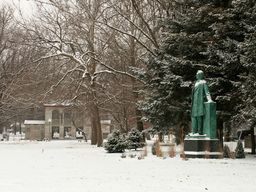 A snowy day in Carle Park west of the Urbana High School. On the right is a statue of Abraham Lincoln by Lorado Taft.
|
|
| Country | United States |
|---|---|
| State | Illinois |
| County | Champaign |
| Elevation | 728 ft (222 m) |
| Coordinates | |
| Area | 11.7 sq mi (30 km²) |
| - land | 11.7 sq mi (30 km²) |
| - water | 0.0 sq mi (0 km²), 0% |
| Population | 39,484 (2007) |
| Density | 3,468.3 / sq mi (1,339 / km²) |
| Founded | 1833 |
| Mayor | Laurel Lunt Prussing (D) |
| Timezone | CST (UTC-6) |
| - summer (DST) | CDT (UTC-5) |
| Postal code | 61801 |
|
Location of Urbana within Illinois
|
|
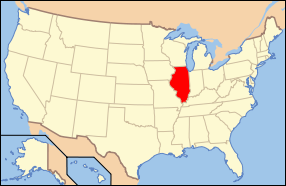 Location of Illinois in the United States
|
|
| Website: www.city.urbana.il.us | |
Urbana (pronounced /ɜrˈbænə/) is the county seat of Champaign County, Illinois, United States[1]. As of the 2007 population estimates, the population was 39,484. The city was named after Urbana, Ohio.
Most of the campus of the University of Illinois at Urbana-Champaign is located here.
Contents |
Geography
Urbana is located at (40.109665, −88.204247)[2].
According to the United States Census Bureau, the city had a total area in 2000 of 10.5 square miles (27.2 km²), of which 0.10% is water body. Current (January 2010) city planning maps indicate that the total area is now 11.7 square miles (30.3 km²).
Urbana shares a border with the neighboring city of Champaign. The site of the main campus of the University of Illinois straddles the border between both cities. Together, these two cities are often referred to as Urbana-Champaign (the designation used by the University), Champaign-Urbana (the more common usage, due to the larger size of Champaign) or the nickname "Chambana". Urbana, Champaign, and the nearby village of Savoy form the Champaign-Urbana Metropolitan Area.
Demographics
As of the census[3] of 2000, there were 36,395 people, 14,327 households, and 6,217 families residing in the city. The official 2000 Census population used is 37,362, however, because of an enumeration error during the original population count. The population density was 3,468.3 people per square mile (1,339.6/km²). There were 15,311 housing units at an average density of 1,459.1/sq mi (563.5/km²). The racial makeup of the city was 67.01% White, 14.34% African American, 0.18% Native American, 14.24% Asian, 0.04% Pacific Islander, 1.76% from other races, and 2.45% from two or more races. Hispanic or Latino of any race were 3.54% of the population.
There were 14,327 households out of which 20.1% had children under the age of 18 living with them, 32.2% were married couples living together, 8.7% had a female householder with no husband present, and 56.6% were non-families. 36.6% of all households were made up of individuals and 8.1% had someone living alone who was 65 years of age or older. The average household size was 2.14 and the average family size was 2.83.
In the city the population was spread out with 14.9% under the age of 18, 36.2% from 18 to 24, 26.4% from 25 to 44, 13.2% from 45 to 64, and 9.3% who were 65 years of age or older. The median age was 25 years. For every 100 females there were 111.3 males. For every 100 females age 18 and over, there were 111.7 males.
The median income for a household in the city was $27,819, and the median income for a family was $42,655. Males had a median income of $32,827 versus $26,349 for females. The per capita income for the city was $15,969. About 13.3% of families and 27.3% of the population were below the poverty line, including 24.5% of those under age 18 and 7.2% of those age 65 or over.
Student Population
Urbana houses a significant fraction of the roughly 40,000 college students attending the University of Illinois at Urbana-Champaign. A majority of the University of Illinois campus is located within the Urbana city limits.
Transportation
Downtown Urbana is located southwest of the intersection of its two busiest streets: U.S. 150 (University Avenue) and U.S. 45 (Vine Street-Cunningham Avenue).
Most of Urbana lies south of I-74. There are three exits (from west to east): Lincoln, Cunningham and University. The Lincoln exit is closest to the University of Illinois, while the Cunningham exit goes to downtown Urbana. The University exit goes to downtown Urbana as well as Illinois Route 130 to Philo.
The Norfolk Southern operates an east to west line through Urbana. The NS line connects industries in eastern Urbana to the Norfolk Southern main line at Mansfield, Illinois, west of Champaign. The line now operated by Norfolk Southern is the former Peoria & Eastern Railway, later operated as part of the Big Four (Cleveland, Cincinnati, Chicago and St. Louis Railway), New York Central, Penn Central, and Conrail systems, being sold by Conrail to Norfolk Southern in 1996. Construction of the line was begun by the Danville, Urbana, Bloomington and Pekin Railroad. This short-lived entity became part of the Indianapolis, Bloomington and Western Railway before the railroad was completed. A branch line of the Norfolk and Western Railway used to connect Urbana with the main line from Danville to Decatur at Sidney, Illinois, but this was first rerouted and later closed.
Willard Airport serves the city.
Government
Urbana has Mayor-Council government, of the strong-mayor form. The city council has seven members, each elected from a different ward. The mayor is elected in a citywide vote.
Culture
Market at the Square

The Market at the Square (otherwise known as the Farmers' Market) has been a community event in Urbana since 1979.[4] Every Saturday morning from some time in May to some time in November, dozens of vendors set up shop in the Lincoln Square parking lot in downtown Urbana. They primarily sell local produce (including corn, tomatoes, and watermelons), but one can also find local crafts, music, and booths for various community and political organizations.
Urbana Free Library
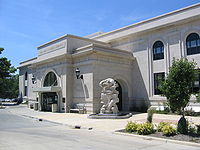
The Urbana Free Library is located in the downtown area. The library is one of the first public libraries in Illinois and was founded in 1874.[5] The library houses historical archives of Champaign County which can be used for genealogical research. The historic building which houses the library was built in 1918. A major new addition was opened in 2005.
The library is publicly funded and receives additional support from about 600 people who have joined "The Friends of the Urbana Free Library".
Station Theatre
Station Theatre, run by the Celebration Company, hosts live performances.
The Urbana Sweetcorn Festival
The Urbana Sweetcorn Festival is an annual festival in Urbana, Illinois.
The first Urbana Sweetcorn Festival was held in August 1975 in the Busey Bank parking lot in downtown Urbana. It was a community event put on by employees of Busey Bank. Since then the Sweetcorn Festival has continued to grow. The Urbana Business Association is now responsible for the planning of the festival, over the years adding a local car show, an expanded family area, live music on multiple stages, food, vendors, beer, in the heart of downtown Urbana.
In addition to corn and beverages, the festival has offered a range of activities and events, including a display of antique and other collectors' cars and volksmarches, arts events, a dog show, and a book sale organized by the Friends of the Urbana Free Library.[6][7][8]
Candlestick Lane

Candlestick Lane is the name for a neighborhood in eastern Urbana. It is called Candlestick Lane because every year the residents decorate their yards for Christmas with lots of lights and figures. The tradition began in 1961 (maybe 1960) as a house-decorating contest sponsored by the Illinois Power Company.[9]
Lincoln Hotel
The Lincoln Hotel is connected to Lincoln Square Mall, an indoor walking mall, in the center of Urbana. The hotel was built in 1924 in a mixture of classic European styles. It was completely remodeled in 1977, and a number of new rooms were added to the top floor. It was officially closed and auctioned off in 2009.
Points of interest
- University of Illinois at Urbana-Champaign
- University of Illinois Arboretum
- University of Illinois Conservatory and Plant Collection
- Krannert Center for the Performing Arts
Urbana in film
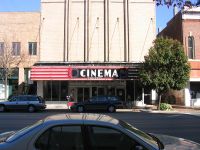
In the 1968 film, 2001: A Space Odyssey, Urbana was named as the location where the malfunctioning HAL 9000 computer of the ill-fated Discovery Mission to Jupiter was programmed. The 1959 comedy Some Like it Hot also mentions Urbana. Near the beginning of this film, Jack Lemmon's character, an unemployed bass player, suggests to Tony Curtis, a saxophone player, that the two visit Urbana to play at the University of Illinois. Instead, the two musicians elected to join a women's band in Florida.
Urbana provides the setting for Bert I. Gordon's 1957 science fiction film, Beginning of the End. Parodied on the television program, Mystery Science Theater 3000, this movie features the unintentional creation of dangerous, giant grasshoppers as a result of agricultural research gone awry.
Urbana in literature
Spanish writer Javier Cercas uses Urbana as the geographical background for two of his novels ("La velocidad de la luz" (2005) and "El inquilino" (1989)).
Education
Urbana High School
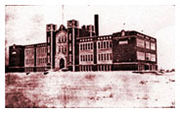
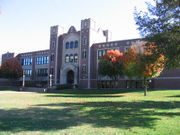
Urbana High School's current building was built in 1914. It was designed by architect Joseph Royer who also designed many other area buildings such as the Urbana Free Library and the Champaign County Court House. The architecture is of the Tudor style defined primarily by the towers over the main entrance and flattened point arches over the doors.
An addition was built in 1916, which included a gymnasium and swimming pool. Due to increasing enrollment, other additions were built in 1955 and in 1965. In 1988, an enclosed athletic area was added and the old gymnasium/pool wing was converted into classrooms. The entire building was also renovated to meet safety codes. The Urbana Park District Indoor Aquatic Center was built in 2003, adjoining Urbana High School and bringing the building to its current visage.
Film critic and Urbana native Roger Ebert is a graduate of Urbana High School. During his senior year he was co-editor of the school newspaper, the Echo.
University Laboratory High School
Not part of the Urbana School District, University Laboratory High School is a publicly funded laboratory school located on the campus of the University of Illinois in Urbana. It was founded in 1921.
Urbana Middle School
Urbana Middle School was first used as Urbana Junior High School in 1953. Since then, the school has been renovated for space in 2003. The school currently serves 1047 students from grades 6 to 8. The school is renowned for its band program, which went to the Illinois State Band Competition (Superstate) twelve years in a row from 1994–2006.
Urbana Elementary Schools
The Elementary schools in Urbana are: Leal, King, Prairie, Thomas Paine, Wiley, and Yankee Ridge.
Test scores
Urbana Middle School and all elementary schools in the Urbana School District passed their Adequate Yearly Progress in the 2005–2006 school year, as determined by scores in the Illinois Standards Achievement Test. However, Urbana High School (by way of the Prairie State Achievement Examination) did not. University Laboratory High School students do not take these tests because, despite the fact that University High is a public school, it is not part of a local school district[10].
Parks

Carle Park, established in 1909, is located at Indiana and Garfield, just west of Urbana High School in Central Urbana. Measuring 8.3 acres (34,000 m2), it contains a statue entitled Lincoln the Lawyer by Lorado Taft and more than 50 well-established trees that are part of the Hickman Tree Walk.
Meadowbrook Park is located southeast of the Race Street and Windsor Road intersection. The park covers 130 acres (0.53 km2), including 80 of recreated Illinois tallgrass prairie. Around the prairie restoration center of the park loops a wide concrete path, suitable for walking, running, and bicycling. Several small hills make the path unsuitable for inexperienced inline skaters. The path is adorned by about twenty large sculptures from local artists. A playground, shelter, and parking lot are located near the Windsor Road entrance. A community garden, an herbal garden, the Timpone Ornamental Tree Grove and a shelter are located near the Race Street entrance. The park also contains many streams which are among the first tributaries of the Embarras River.
The Urbana Dog Park, located on East Perkins Road, is a place to walk one's dog without a leash.
The Anita Purves Nature Center, located on the north end of Crystal Lake Park, offers nature education programs.
To find about the other parks and recreational areas in Urbana, see Urbana Park District Facilities
Swimming Pools
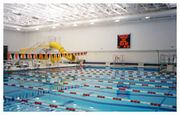
The Urbana Indoor Aquatic Center is a public indoor pool operated by the Urbana Park District and Urbana School District. It is located between Urbana High School and Urbana Middle School.
Crystal Lake Pool is a public outdoor pool. It is located on Broadway Street, across from the Anita Purves Nature Center. It closed permanently after the summer 2008 season due to deteriorating conditions and consequent safety issues.
Windsor Swim & Tennis Club is a privately owned facility in south Urbana that offers swimming lessons, day camp for kids, and more. The club closed permanently after the 2009 swim season.
Campus Recreation Center East (CRCE) has an indoor pool with a water slide, volleyball, basketball, and a hot tub. CRCE is owned by the University of Illinois at Urbana-Champaign.
Freer Hall and Kenney Gym both have indoor lap pools. These facilities are owned by the University of Illinois at Urbana-Champaign.
Media
FM Radio
- 88.1 W201CK (Translates 90.7 KHRI) "Air 1", Christian CHR
- 88.7 WPCD, College Radio
- 89.3 WGNJ, Religious
- 90.1 WEFT, Community Radio, Variety
- 90.9 WILL, Classical music (RDS), broadcasting from Urbana
- 91.7 WBGL, Christian AC (RDS)
- 92.5 WCFF "92.5 The Chief", Adult Hits (RDS – Artist/Title)
- 93.5 WEBX "93.5 The Source" Modern Rock (RDS)
- 94.5 WLRW "Mix 94.5" Hot AC (RDS – Artist/Title) (HD Radio)
- 95.3 WEVX "95.3 The Wolf" Country (RDS)
- 96.1 WQQB "Q 96", CHR/Pop (RDS)
- 97.5 WHMS-FM "Lite Rock 97.5" Adult Contemporary
- 99.1 WYXY "Extra 99.1" Rock (RDS – Artist/Title)
- 100.3 WIXY "WIXY 100.3" Country (RDS – Artist/Title)
- 100.9 WHPO "100.9 WHPO" Country
- 101.1 W266AF (Translates 90.9 WILL), Classical music
- 102.5 WGNN, Religious
- 103.9 W280DE (Translates 102.5 WGNN), Religious
- 104.5 WRFU-LP "Radio Free Urbana", Community/Political Activism [1], broadcasting from Urbana
- 105.5 WCZQ "Blazin" Hip Hop and R&B
- 105.9 WGKC "Classic Rock 105.9 WGKC" Classic Rock
- 107.1 WPGU "No Rules Radio" Alternative
- 107.9 WUIL "107.9 JAMZ" Hits & Hip-Hop
AM Radio
- 580 WILL, Public Radio, broadcasting from Urbana
- 1400 WDWS, News/Talk (AM Stereo)
- 1460 WJCI, Hispanic
- 1580 WBCP, Urban Adult Contemporary
- 1660 Latino Radio Service Latino [2]
Analog Television
- 3 WCIA, CBS
- 7 W07DD, Three Angels Network
- 12 WILL, PBS
- 15 WICD "NewsChannel 15", ABC
- 17 WAND, NBC
- 23 WBUI, The CW
- 27 WCCU "Fox 55/27"
- 34 W33AY, Trinity Broadcast Network
- 44 WBXC-CA, MTV 2
- 49 WCFN "My WCFN TV", My Network TV
- 51 WEIU, PBS
Digital Television (DTV)
- 9 WILL-DT, PBS
- 18 WAND-DT, NBC
- 22 WBUI-DT, WB
- 26 WCCU-DT, Fox
- 41 WICD-DT, ABC
- 48 WCIA-DT, CBS
- 50 WEIU-DT, PBS
- The News-Gazette, daily local newspaper
- Daily Illini
- Buzz Weekly
- The Booze News
- The Public I indie media newspaper
Notable people
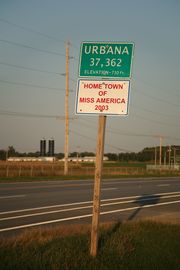
- Philip W. Anderson, earned the Nobel Prize in Physics in 1977.
- LaToya Bond, professional basketball player (WNBA & International).
- Iris Chang, author of The Rape of Nanking.
- Brady Dougan, CEO of Credit Suisse Group.[11]
- Roger Ebert, movie critic and Pulitzer Prize winner.
- Jennie Garth, actress, starring in What I Like About You, Beverly Hills, 90210 and 90210.
- Theodore Gray, co-founder of Wolfram Research and winner of the Ig Nobel Prize in Chemistry in 2002.
- HAL 9000, character in the film 2001: A Space Odyssey, who upon "dying" claims he was made operational in Urbana.
- Erika Harold, Miss Illinois 2002 and Miss America 2003. Urbana High graduate.
- Robert W. Holley, Nobel Prize in Physiology or Medicine in 1968, Urbana High School class of 1939.
- Cyril G. Hopkins (1866-1919), Professor of Agronomy-UIUC , prolific author, and pioneer of scientific farming practices.
- Braj Kachru, linguist who created the "circle model" of world English varieties.
- Shahid Khan, new majority owner of the St. Louis Rams (2010), graduate of the University of Illinois.
- Edwin G. Krebs, Nobel Prize in Physiology or Medicine in 1994, Urbana High School class of 1937.
- Paul Christian Lauterbur, earned the Nobel Prize in Physiology or Medicine in 2003.
- Sir Anthony James Leggett, earned the Nobel Prize in Physics in 2003.
- Patrick Norton, technology host (formerly of The Screen Savers).
- Chic Sale, author, actor, and vaudevillian.
- Mary Murphy Schroeder, Chief Judge of the United States Court of Appeals for the Ninth Circuit.
- Hamilton O. Smith, earned Nobel Prize in Medicine in 1978.
- David Ogden Stiers, actor best known for his role as Major Charles Emerson Winchester III on the TV show M*A*S*H.
- James Tobin, earned Nobel Prize in Economics in 1981.
- Brian Wansink, author of Mindless Eating: Why We Eat More Than We Think and professor at Cornell University.
- Carl Woese, microbiologist who identified Archaea as a kingdom of life.
- Jay Bennett, founding member of Wilco and solo musician who died in May 2009.
- David Foster Wallace, author of Infinite Jest, graduate of Urbana High School.
- Gil Shaham, world-famous violinist.
- Ella Masar, American soccer forward, member of Chicago Red Stars and US Women's National Soccer Team.
References
- ↑ "Find a County". National Association of Counties. http://www.naco.org/Template.cfm?Section=Find_a_County&Template=/cffiles/counties/usamap.cfm. Retrieved 2008-01-31.
- ↑ "US Gazetteer files: 2000 and 1990". United States Census Bureau. 2005-05-03. http://www.census.gov/geo/www/gazetteer/gazette.html. Retrieved 2008-01-31.
- ↑ "American FactFinder". United States Census Bureau. http://factfinder.census.gov. Retrieved 2008-01-31.
- ↑ Market at the Square
- ↑ "The Urbana Free Library 1874 - Present". http://urbanafreelibrary.org/about/history/. Retrieved July 13, 2010.
- ↑ Wilkey, Maureen (August 27, 2004). "Corn festival comes to C-U". Daily Illini. http://www.illinimedia.com/di/news/2451. Retrieved 2008-04-07.
- ↑ Puhala, Bob (August 9, 1987). "It's time for corny fun at Midwest festivals". Chicago Sun-Times: p. 15. http://nl.newsbank.com/nl-search/we/Archives?p_product=CSTB&p_theme=cstb&p_action=search&p_maxdocs=200&p_topdoc=1&p_text_direct-0=0EB36D7E4CD624A4&p_field_direct-0=document_id&p_perpage=10&p_sort=YMD_date:D&s_trackval=GooglePM. Retrieved 2008-04-07.
- ↑ Kline, Greg (August 18, 2003<!- – 2:00 PM CDT -->). "Putting the sweet in corn". The News-Gazette (Champaign, Illinois). http://www.news-gazette.com/news/local/2003/08/18/putting_the_sweet_in_corn. Retrieved 2008-04-07.
- ↑ "Candlestick Lane Debut" by Tom Kacich, The News-Gazette Weblog
- ↑ Becky McCabe, Division Administrator, Student Assessment Division (August 21, 2006). "Memorandum:2006–07 Guidance – Graduation and the Prairie State Achievement Examination" (PDF). Illinois State Board of Education. http://www.isbe.state.il.us/assessment/pdfs/psae_grad_guid_memo.pdf. Retrieved April 20, 2007.
- ↑ Christine Harper and David Clarke, "American Dougan Emulates Gruebel at Credit Suisse," Bloomberg.com http://www.bloomberg.com/apps/news?pid=20601109&sid=akg3Dpvfufoc
External links
- City of Urbana (official website)
- Urbana Free Library
- Champaign-Urbana Historic Built Environment Digital Image Collection
- Urbana Park District – local parks, pools, and other recreation
- Early History of Urbana City
|
|||||||||||||||||||||||
|
|||||||||||||||||